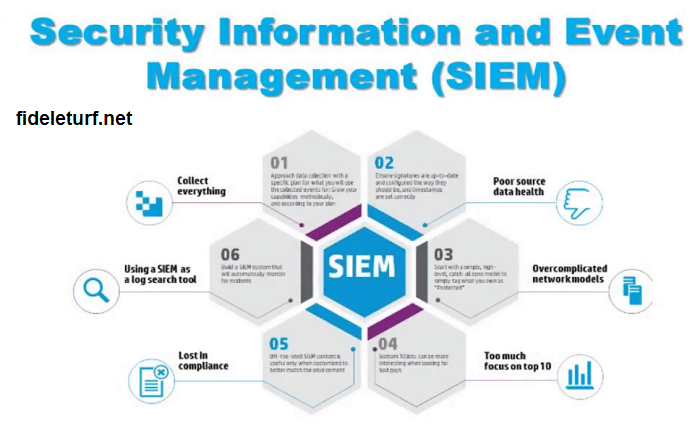The Role of Security Information and Event Management in Cybersecurity

Key Takeaways:
- Understanding the vital role of SIEM systems in contemporary cybersecurity efforts provides organizations with a proactive stance against threats.
- Comprehending SIEM mechanics, effective deployment, and ongoing management is essential for defending against sophisticated cyber attacks.
- Keeping up-to-date with SIEM technology trends and industry news enables cybersecurity professionals to adapt to new challenges.
Introduction
In an era where digital threats loom larger than ever, the value of a comprehensive and efficient cybersecurity strategy is indisputable. Security Information and Event Management (SIEM) is at the forefront of this defense, and it stands as a cornerstone technology for organizations seeking to mitigate the risk of cyber threats. A SIEM system aggregates and interprets security-related data across an enterprise’s IT infrastructure, serving as a central hub for alert analysis and incident response. Integrating a SIEM solution within a corporate security strategy can significantly streamline the detection, analysis, and neutralization of cybersecurity threats.
SIEM technology does more than collect data—it provides actionable insights that translate into a responsive defense mechanism. Spanning from log management to sophisticated event correlation, SIEM systems consolidate the otherwise dispersed security events into a structured framework that aids organizations in making informed security decisions. As cybercriminals employ increasingly complex tactics, the need for versatile and dynamic security tools like SIEM becomes more pronounced, making it an invaluable asset in the arsenal of cybersecurity professionals.
The Significance of SIEM in Modern Security Infrastructure
The advent of SIEM technology marks a pivotal shift in how businesses approach cybersecurity. SIEM solutions provide a unified view of an organization’s security risks, enabling IT security teams to detect patterns and anomalies that may indicate a security breach. It simplifies the formerly overwhelming task of manually combing through logs by automating collecting, aggregating, identifying, and responding to threats across myriad systems and applications.
SIEM plays an especially significant role in the context of sophisticated attacks and persistent threats, which require correlation of events over time. With its centralized monitoring capabilities, SIEM optimizes security processes and aligns them with business objectives by safeguarding critical digital assets essential for maintaining operational continuity and securing customer trust.
Understanding the Mechanics of SIEM
The foundational premise of SIEM is its ability to correlate data from various security feeds. Event logs, which are the records created by network devices, operating systems, and applications, form the lifeblood of SIEM. These logs are collected in real-time, allowing SIEM systems to conduct instantaneous analysis, identify security incidents as they occur, and initiate an appropriate response.
Correlation rules within a SIEM platform can detect complex behavioral patterns, such as repeated login failures followed by a successful entry—potentially signaling a brute force attack—or large data transfers after hours, which could indicate data exfiltration. By setting up these rules, organizations leverage SIEM to move away from reactive security positions to proactive threat hunting and mitigation efforts.
Best Practices for SIEM Deployment
To harness the full potential of SIEM technology, it’s crucial to consider deployment best practices. Key among these is the recognition that SIEM is not a set-it-and-forget-it solution; rather, it requires ongoing calibration to ensure that it is finely tuned to the organization’s specific security needs. Evaluating the scalability of the SIEM solution to align with business growth is also significant, as is the system’s interoperability with existing security tools and infrastructure.
Effective SIEM deployment also entails establishing clear objectives for what the system is expected to accomplish. Whether the primary goal is compliance, real-time threat detection, or both, defining these objectives upfront can guide the customization and optimization of the SIEM platform. Proper staffing is another critical aspect; having a team with the requisite expertise to configure, monitor, and maintain the system is indispensable for success.
SIEM and Compliance: Navigating the Regulatory Landscape
SIEM systems don’t just enhance security posture but are pivotal in helping organizations comply with regulatory standards like GDPR, HIPAA, or PCI DSS. For many IT departments, the compliance capabilities offered by SIEM alleviate the burden of manually producing necessary reports and documentation during audits, thereby reducing the resources and time typically devoted to compliance activities.
The value of SIEM in meeting compliance requirements extends to delivering insights that drive improvements in security practices. For example, the continuous monitoring enabled by SIEM platforms assists in identifying not only active security threats but also areas where security controls may be enhanced to protect more sensitive data—a proactive approach to compliance that regulators look upon favorably.
Overcoming Common Challenges with SIEM
One of the most pressing challenges in SIEM management is the delicate balance between capturing enough data to be effective and avoiding an overload that results in a flood of false positives. Sophisticated SIEM systems can alleviate this by incorporating advanced analytics that sift through data more intelligently, flagging only those events that warrant further investigation. Continuous refinement of SIEM rules and parameters is an ongoing process that benefits from the lessons learned from previous security incidents.
As SIEM becomes more integral to the security operations center (SOC), its integration with other sophisticated tools, like user and entity behavior analytics (UEBA) and endpoint detection and response (EDR) platforms, also merits attention. This level of integration is not just about data sharing but also about creating a synergistic environment where each tool enhances the capabilities of the others in the context of an overarching security strategy.




